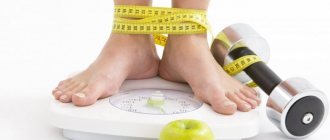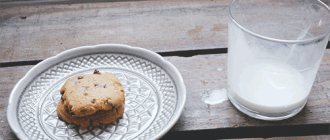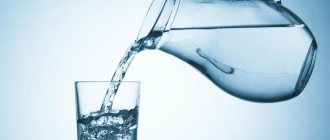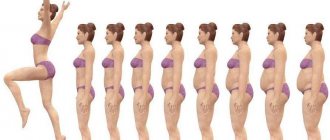Physiologists and fitness trainers recommend doing sports for at least an hour . Moreover, during this hour the intensity of physical activity should not decrease, this means that the muscles should not “cool down”. Breaks are allowed to restore breathing and replenish fluid loss, then the workout should continue. The effectiveness of fat burning depends on the correct distribution of the load during exercise.
Why should you exercise for at least an hour to burn fat?
Any movement we make requires energy expenditure. The main energy molecule is ATP (adenosine triphosphoric acid) from which calories are formed. It is formed during the breakdown of carbohydrates and fats.
During physical activity, carbohydrates are primarily “burned” to produce ATP energy. It is these compounds that are the simplest and most accessible, since they are constantly present in the blood plasma. When their concentration decreases, the body begins to use reserves. Simple blood sugar is enough for only 10 minutes of aerobic exercise. During aerobic exercise, the most important thing is breathing control, since the appearance of shortness of breath leads to a lack of oxygen necessary for the process of burning calories.
Energy reserves include two main compounds: glycogen and fats. The breakdown of protein compounds should not occur, since they are building materials and their catabolism may lead to the development of serious pathologies.
Glycogen metabolism
The main storage of glucose in the body is glycogen. After eating, excess glucose entering the bloodstream under the influence of insulin is utilized in the muscles and liver, where glycogen is formed. The main depot is the liver, but muscle glycogen is the first to be consumed during intense physical activity.
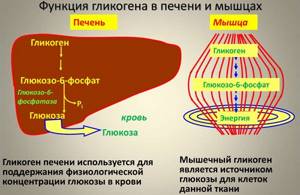
The more muscle fibers there are, the less time it takes for muscle glycogen stores to deplete. Once the energy from the above sources has run out, liver glycogen begins to be metabolized.
Fat metabolism
The second source of glucose when it decreases in the blood is fat catabolism. It is much more complex than the breakdown of glycogen and takes longer. Since first fat, breaking down into triglycerides and fatty acids, enters the blood from lipids and only then, after entering muscle cells, burns kilocalories, metabolizing to glucose.
During the training process, fat metabolism begins after about an hour of physical activity. Then, after exercise, the muscles restore glycogen deficiency at the expense of fat deposits. Static and power loads lead to an increase in muscle mass, which, in turn, increases energy consumption and accelerates fat burning.

Also, the acceleration of fat burning occurs under the influence of many hormones, mainly anabolic. This occurs due to the fact that they trigger the growth of muscle fibers, which requires energy expenditure. The greater the muscle mass, the more energy is needed to work the muscles, therefore, fat burning is significantly accelerated.
How calories are burned with a quiet lifestyle

How many calories do you need to burn per day to lose weight?
In a state of calm
In a state of calm, the body still spends a certain amount of calories. Therefore, even without doing anything, you need to eat, otherwise the body may become exhausted. There is a formula that helps you understand how many calories each person needs at rest. Here you will need to know your body weight in kilograms, height in centimeters, age in years. Let our woman weigh 65 kilograms, have a height of 168 centimeters and her age reach 38 years. Then you get the following figure:
655+9,6*65+1,8*168-4,7*38=655+624+302,4-178,6=1402,8.
This is exactly how many kilocalories per day, as the calculator shows, you need to eat so that the body can burn all the energy received. If the question is about losing weight, then you need to consume less high-calorie foods or engage in physical exercise.
What types of exercise are suitable for burning fat?
The most effective for burning fat is cardio exercise, since constant dynamic muscle work requires more energy. These include:
- Jogging. During the first 20 minutes, glucose is burned, since measured running uses many muscles in our body, then the catabolism of fat deposits is involved in correcting ATP deficiency. Deep, even breathing (no shortness of breath) allows you to sufficiently oxygenate the blood, improving energy metabolism. The cardiovascular system is also trained, which is activated for sufficient blood supply and efficient functioning of the skeletal muscles.
- Dancing. Dynamic, complex movements to the beat of music are effective. Moreover, during dancing, the amount of endorphins in the blood (pleasure hormone) increases, which speeds up metabolic processes and reduces the feeling of fatigue, increasing performance.
- Swimming. With the correct technique, almost all muscles are involved in this sport. Since water is denser than air, more force is required to move the muscle, which increases calorie consumption. Unfortunately, this method of burning fat is not available to everyone, since sufficient lung volume and proper breathing skills in water are required for sufficient oxygen supply, since calorie burning under anaerobic conditions is impossible.
- A ride on the bicycle. A good alternative to jogging, in addition to working the leg muscles, the core muscles are also involved to maintain balance.
The effectiveness of strength training in the gym cannot be denied. They are necessary for increasing muscle mass and more effective aerobic exercise, since the more muscles, the more energy they need and the faster fat burning occurs.
In continuation of the topic, be sure to read:
- Details about the coprogram: preparation, conduct and interpretation of the analysis
- Rectal fissure: causes, symptoms and treatment of pathology
- More about hemorrhoids: causes, symptoms and treatment methods
- Rectal cancer: symptoms, stages, treatment and prognosis for life
- Irritable bowel syndrome: symptoms and treatments
- The procedure for performing an enema with a syringe to cleanse the intestines
- Natural Methods to Speed Up Metabolism
- What medications should I use for increased gas formation?
- Details about bowel cancer: stages, symptoms, treatment and prognosis
- What determines the level of glucose and what are its normal levels in the blood?
How many calories per hour does it take to train?
How many calories do you need to burn per workout to get the weight loss effect? There are different types of exercises and physical activity. For example, with interval training, up to 900 kcal are consumed per hour of training. Moreover, even after 15 minutes of exercise, the body will use fat reserves to recover if the person’s nutrition is correct.
How many calories are burned when climbing stairs?
Cardio training burns from 500 to 800 kcal. It’s just important to remember that you need to exercise for at least an hour, since fat reserves will begin to melt only after 20 or 30 minutes of exercise. Endurance plays a big role here.
Important! The more resilient your body is, the more fat you can burn.
Memo
- 70% of success in losing weight depends on proper and healthy nutrition.
- Do not be tempted to go on a short-term crash diet - its consequences can greatly harm the body and metabolism
- Keep in mind the proportion of BZHU and the approximate calorie content of your diet
- Choose any type and direction in sports, the main thing is not to sit still and be active
- Write down a clear goal, clearly imagine yourself in the body you dream of, and let this image accompany and spur you on all the way.
Losing weight seems difficult when you don’t know which way to approach it and where to start. In fact, everything is simple. Do you want to get rid of excess weight without exhausting workouts, nerves and tension?
Enter your email, click the download button ↓
Diets are bad
You can lose weight by sharply limiting your food intake, but alas, not for long. With rapid and unhealthy weight loss, a seesaw effect is triggered.
For example: before your vacation you decide to lose a couple of kilos and practically stop eating. Some kilograms go away, you are happy, you go on vacation. There you will find the sea, the sun, carelessness and animal hunger. The body, depleted by diet, requires calories, and having received them, it enthusiastically converts the received energy into fat, for storage. Suddenly he gets the idea to go hungry again. You end up gaining more than you lost.
Severe dietary restrictions are harmful
1.7 - 2.2 kg total weight (glycogen + water + fat)
But let's move on.
In the first stages of losing weight, when you begin to strictly monitor the intake of harmful and unnecessary foods or completely exclude them from your diet, your body begins a self-cleaning process, which is accompanied by the removal of all toxins, waste and other preserved poisons accumulated on the walls of your blood vessels , in vital organs and adipose tissue. All this garbage also has some weight, and the more your body was “cluttered” with it, the more of it will be removed through sweat and waste products, and accordingly, the greater the total weight lost at the end of the week.
Also, in the process of losing weight, muscle tissue often suffers, especially for girls and boys who previously led a sedentary lifestyle and have a fairly small muscle mass. So, in the first two weeks, the likelihood that they will lose from 200 to 500 g of their muscle mass immediately increases several times.
Subject to complete fasting
On the first day of fasting, you can actually lose up to 80-100 grams of fat. True, provided that before that you did not torture yourself with hunger and strict diets. Or the situations listed above happened to you a very long time ago.
If you have already fasted or been on a diet, then the fat loss may be 0-50 grams. Yes, that's not a typo. You can actually go hungry all day and lose only water and muscle mass, leaving your body fat intact.
This is because when fasting, the body not only reduces its metabolic rate, but also “remembers” the experience. The next time he is deprived of food, he will already be saving fat and getting rid of muscle, because muscles are using up too much energy.
As for the second and subsequent days of fasting, every day fat loss rapidly decreases, and after 5-10 days it certainly approaches zero. Therefore, long-term fasting for weight loss is useless. In addition, when fasting ends, the body begins to intensively store fat.
This is a manifestation of the law of self-preservation. The body tries to save the owner from possible starvation. He has no idea that you are struggling with the kilos - in his opinion, you simply need them. After all, hunger is ahead! So fasting will not help you lose weight - that's a fact.
Bicycle on the street for weight loss.
Again, classes should be started gradually! Increase the load from 10-15 minutes in the first 1-2 weeks and up to an hour or two subsequently. But don’t force things, classes should bring you pleasure, you don’t need to ride until you are completely exhausted! Start, if necessary, with leisurely bike rides, they will also bring considerable benefits. Cycling is very good for weight loss.
Classes should be regular, 3-4 times a week.
What are the benefits of cycling?
- First of all, they train the heart, train all muscle groups, and activate joints.
- Thanks to these workouts, coordination of movements improves, you become more resilient.
- Thanks to these activities, you will develop a beautiful figure and reduce the appearance of cellulite.
- Training takes place in the fresh air, which means your lungs work under heavy load. They receive a large amount of oxygen, and it triggers mechanisms in the body that help burn excess fat.
- But just remember, if any pain in the joints appears, you should stop exercising that day.
- Don't force things, don't try to set records. The optimal driving speed for you is 15-20 km/h.
- The pulse rate should not exceed the maximum allowable.
There are also other rules :
Before training, do not eat anything for at least an hour and a half.
During training, periodically take a sip of water, unsweetened green or herbal tea, or highly diluted juice.
After training, also try not to eat for a while.
These classes are great for burning fat and losing weight - depending on the intensity of the workout, you spend about 500-700 kcal, and in a month you will reliably say goodbye to 2-8 kg.
And don’t worry about “pumping up your legs” - because the muscles will take the place of the “orange peels”!
Basic principles of healthy weight loss
Don't lose weight quickly
This is a long process that will require a lot of time and energy. At first, you will feel discomfort due to changes in habits, nutrition and daily routine. Hold on and keep a diary: every week, enter measurements of the weight and volume of problem areas. Tracking positive changes and dynamics encourages you not to give up what you started.
Don't expect results right away. Wait later, but what?
Set a clear goal
“Losing weight” is a short-term and not particularly inspiring goal. But desires in the spirit of “run a marathon in a year, lose 5 kilos and fit into your favorite jeans” are more suitable. Even if in the end there will be no marathon.
Set long-term goals
Lose weight alone
Don't look for a weight loss partner. It can break and lead you astray. You can find like-minded people, discuss progress with them and share advice, but don’t forget that achieving your goal depends only on you.
Don't join group weight loss groups


